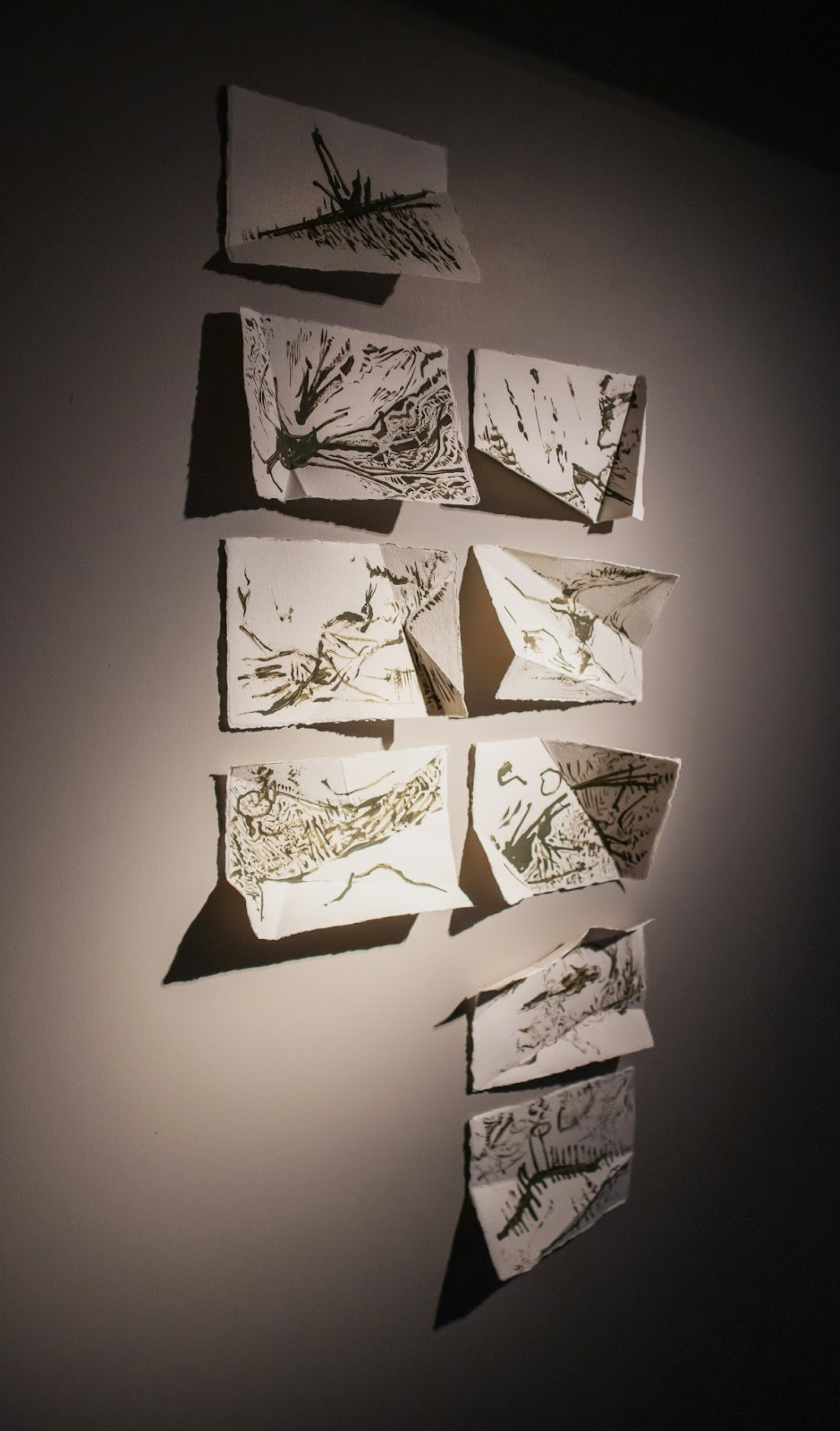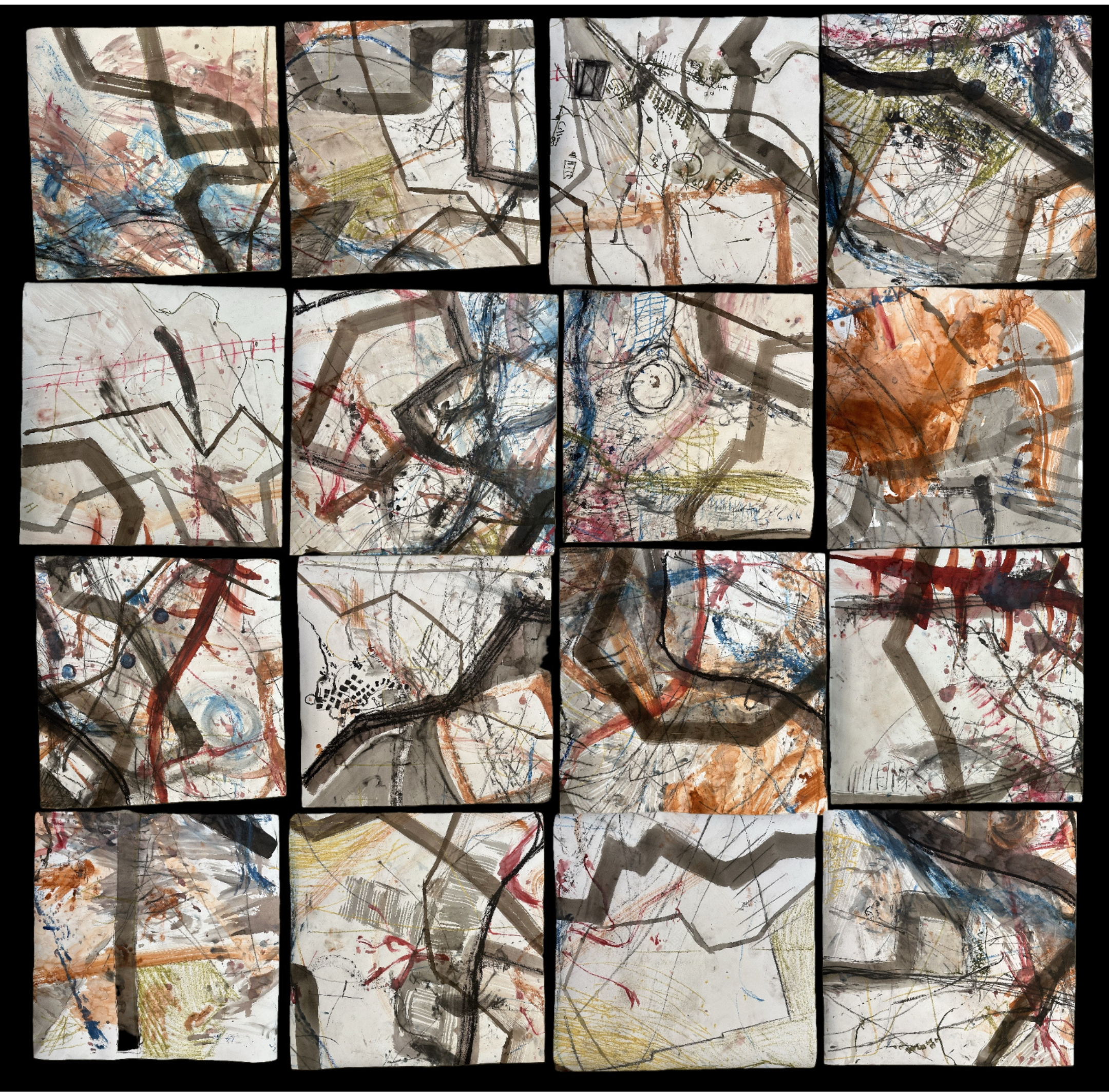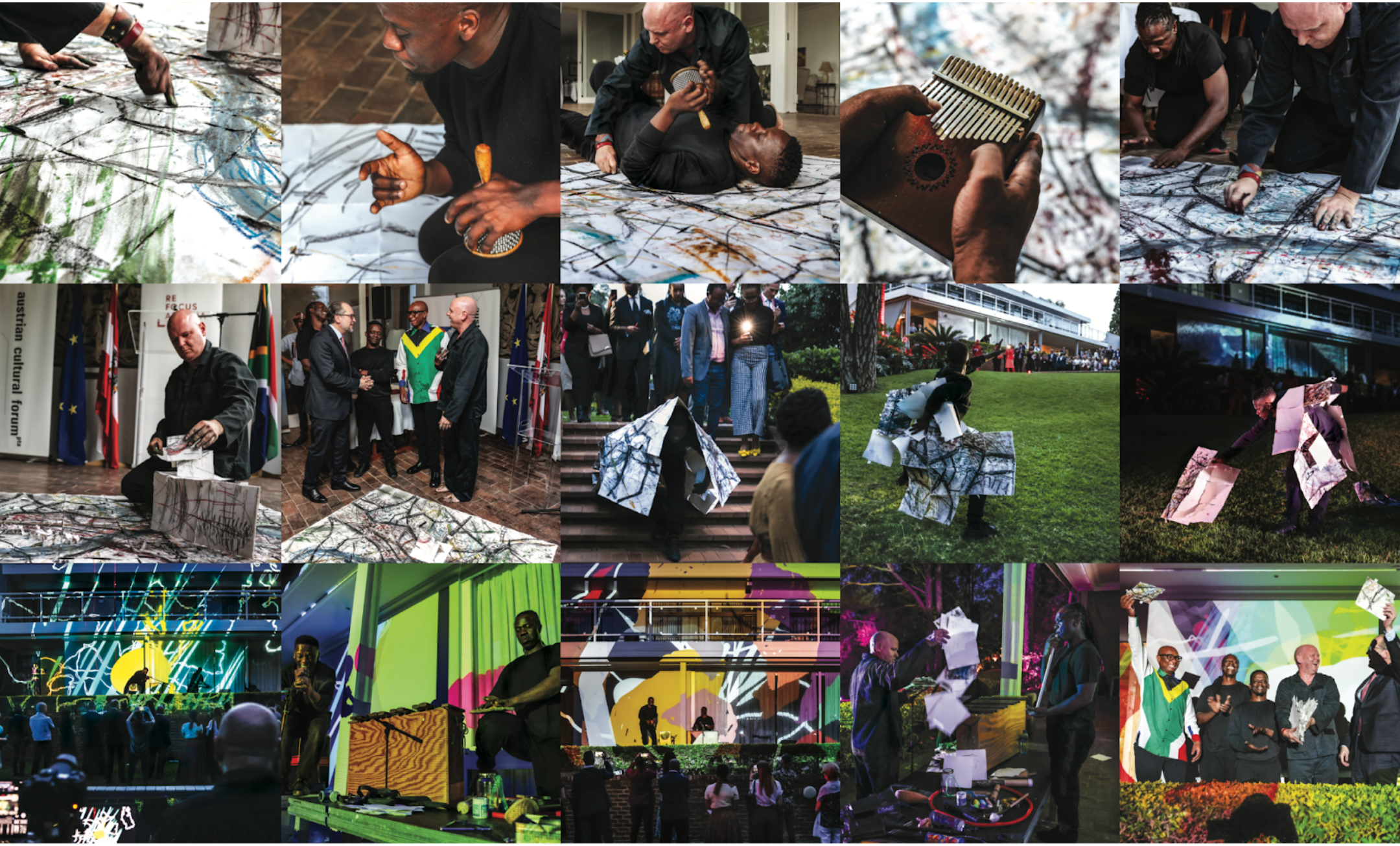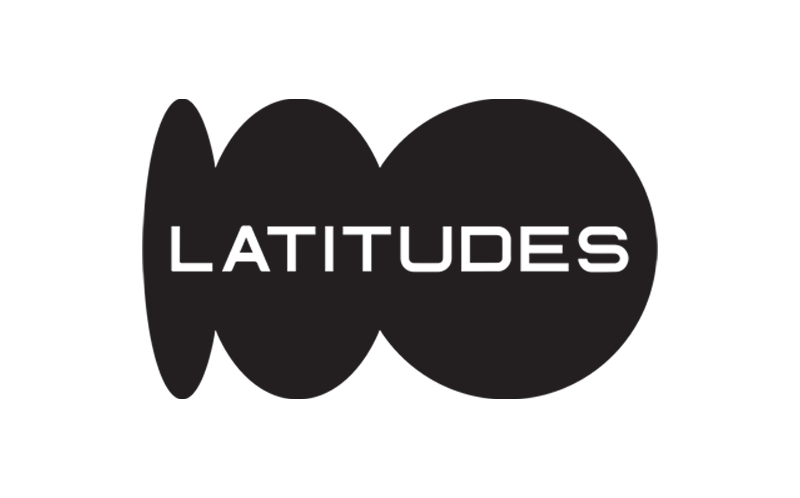When We Mistake the Map for the Territory…
Provocations from the immersive studio of Marcus Neustetter
 Marcus Neustetter, live drawing and building projection at RMB Latitudes 2025, photo by Anthea Pokroy
Marcus Neustetter, live drawing and building projection at RMB Latitudes 2025, photo by Anthea Pokroy
To mark the opening of the RMB Latitudes Art Fair 2025, Marcus Neustetter—supported by the Austrian Cultural Forum Pretoria—presented a live drawing and building projection. Rooted in his long-standing preoccupation with maps and the lines that divide and occupy territories, the work responds to today’s metacrisis with a provocative question: Are we following pre-drawn maps so rigidly that we no longer perceive what is truly happening in the territory itself?
Accompanied by recorded voices and sounds from Anathi Conjwa, Micca Manganye, and Xolisile Bongwana—collected during previous studio experiments—Neustetter treated the evening as a durational open studio. In this immersive environment, he redrew and reconfigured lines of light live, responding intuitively to the sounds, the site, its context, and its architecture.
Under the same title, Neustetter also joined a panel discussion on the final day of the fair, reflecting on his experiences within both the South African and Austrian art ecosystems. As an artist engaged in both contexts, he drew comparisons, highlighted contrasts, and challenged participants to rethink their approaches to art-making within the shifting global and cultural climate—again questioning the ill-defined “map” of the contemporary art industry.
This feature introduces some of Neustetter’s artistic methodologies and presents a snapshot of the journey leading to this work.
The live act of drawing and mapping as a form of exploration has remained a central tool throughout his career. In the catalogue text for Defining Lines, his 2015 solo exhibition at Gallery AOP, Wilhelm van Rensburg writes:
Lines define much more than cartographic representations of territorial boundaries, Marcus Neustetter seems to be suggesting this with his drawings and performances.
Image on left: Tunisia, Afghanistan, Italy,Rwanda, Nigeria,Thailand, Algeria, Iraq, Mali, Greece, India, Kenya, Burma, Somalia, Korea, Kyrgyz Republic, Bangladesh, France, Peru, Egypt, Ecuador, Russian Federation, Democratic Republic of Congo, Mauritania, Chad, Libya, Colombia, Angola, Yemen, China, Senegal, Mexico, Kazakhstan, Central African Republic, Northern Ireland, Nepal, Uzbekistan, Turkey, Israel, Philippines, Iran, Ukraine, Lebanon, Syria, Pakistan, Saudi Arabia – fractured , 2014, ink on canvas, 1800x1600mm
Image on right: Marcus Neustetter, live drawing and building projection at RMB Latitudes 2025, photo by Chelsea Selvan
They are both noun (naming) and verb (making): they define space as much as they are definitions of space. The lines expound conflicts and conquests, and they are simultaneously definitions of global, political and economic strife. In his drawing performances, Neustetter attempts to imbue the mark with the kind of real-world impact that a line on a territorial map has. Abstracting and isolating the line is as much about escaping the realities of borders and zones of conflict, as it is about contemplating the line itself and the spaces it creates. Neustetter, however, pushes beyond the confines of borders, looking for a creative impulse that might be sparked when two lines run uncomfortably close to each other—giving rise to a series of graphic explosions in the in-between spaces where definition and defining appear to be equally nebulous endeavours.”

Acts in Russian Green (4BO) Model Paint, 2022 Ink on cotton paper ea. 150 x 210mm

In the context of today’s crises—war, environmental collapse, and socio-political upheaval—some of Neustetter’s earlier works have taken on renewed relevance. Their visual language now mirrors the aggression and urgency of the current moment. Their symbolism and content are re-emerging in new artworks and modes of mark-making.
Simultaneously, his practice has evolved—deepening its relationship with lived experience. More than ever, Neustetter invites dialogue with collaborators across disciplines. His work seeks new hybrid expressions to open pathways for audience engagement, perspective-shifting, and impact.
A core strategy involves merging digital projection techniques with analogue methods, exploring the messiness of media interaction on both conventional and unconventional surfaces. Some of the projected images originate from a range of artistic research materials: demilitarised zones, fragmented earth observation sketches, and disjointed historical and colonial reconfigurations of territory. These works balance the aesthetic of the line with the politics of its application. By acknowledging that a map is neither a direct reflection of reality nor a true representation of territory, Neustetter challenges our assumptions and proposes that lived experience—rather than abstraction—offers deeper insight.
As a result, the final works take many forms: temporary projections, permanent large-scale installations, and even a small drawing aboard the International Space Station.


Somewhere over Africa, reworked Sumbandila Satellite images, digital print on fabriano paper, 500x500mm each

Lead the way again, engraving and microscopic map drawing on acrylic, 2022, 10x10x10mm, on board the International Space Station with The Moon Gallery.
Neustetter’s practice, however, extends beyond the visual. Through deep collaborations with artists, philosophers, and scientists, he opens his studio as a generative and immersive space. This isn’t new to him. Over the years, he’s cultivated socially engaged work with Stephen Hobbs as The Trinity Session (thetrinitysession.com) and in his individual projects such as Imaginary Futures (imaginaryfutures.org), The ZoNE (the-zone.at), and Space Shelter Earth (space-shelter.earth).
A recent example of this interdisciplinary process unfolded at the Centre for the Less Good Idea. Neustetter facilitated a two-part collaboration with artists Anathi Conjwa, Micca Manganye, and Thulisile Binda. His only instruction: to have a conversation, in any form, and map it. Through voice and percussion, their exchange gave rise to a collaborative drawing on a large paper surface. The resulting work became a poetic expression of loss, fear, uncertainty, resilience, and hope—a collective territory made tangible. This map, together with the recorded sounds, later formed the basis for a live projection at the Bioscope Independent Cinema and again at the Latitudes Art Fair.
Neustetter has increasingly tested this methodology not just in art but as a framework for building new networks and approaches.
In 2023, at the signing of a cultural agreement between South Africa and Austria—represented by H.E. Mr. Zizi Kodwa and H.E. Mr. Alexander Schallenberg—Neustetter, along with Manganye and Bongwana, created a live, collective map. The map was later deconstructed and distributed to all attendees. Each piece became part of a virtual network, serving as both a symbolic and material provocation for the Austrian Cultural Forum’s ongoing presence in South Africa. The gesture invited reflection on perspective, engagement, and mutual recognition in shaping cultural exchange.

Lost and Found, 2025, mixed media drawing on paper, 3x3m
Both ministers recognized the project as a powerful metaphor for the role of art in fostering empathy, dialogue, and new approaches in political and personal spheres.
Born in South Africa to Austrian parents, Neustetter has long explored the meaning of identity through physical and conceptual border-crossing. Since relocating from Johannesburg to Austria five years ago, his immersive studio practice has brought together collaborators from across Europe and Africa to collectively respond to contemporary crises and imagine alternative futures.
Now, in 2025, Neustetter has reunited with Manganye in Vienna. Together, they co-create a new experimental map and soundscape—combining tools and materials sourced from both South Africa and Austria. Their collaboration unfolds in call and response: drawn lines meet percussion, the visual informs the aural, and vice versa. Neustetter composes an abstract cartography of territories and migration, while Manganye concludes the session with an improvised rendition of Thula Mama.
Thula Mama—meaning “Be quiet, Mama” or “Hush, Mama”—is a lullaby that became a powerful political statement during South Africa’s anti-apartheid movement. Originally a song of comfort, it grew into a symbol of resistance and grief, honouring mothers whose sons were taken to the mines or lost to the struggle. Today, it remains a poignant reminder of music’s power to inspire change and offer solace in times of crisis.
The song’s quiet call to witness—its urging to attend to the things we remain silent about—echoes through Neustetter’s responsive drawing. Together, the music and visual language invite us to reconsider the symbolic maps we’ve inherited. As a final gesture, the artists offered fragments of this new map to members of the Austrian Presidential and Cultural Delegation visiting South Africa—extending not only the abstract network of the map, but also a tangible invitation to collaborate, reflect, and engage.
 Imagine Moments, 2023, Austrian Cultural Forum, Pretoria
Imagine Moments, 2023, Austrian Cultural Forum, Pretoria
Through this evolving body of work, Marcus Neustetter continues to affirm the value of art as a space for critical reflection, cross-disciplinary exchange, and collective imagination—his studio remaining a site of immersive process, where participation, experimentation, and dialogue are central to shaping new ways of seeing and understanding the world.
Further Reading In Articles
African Artist Directory
























